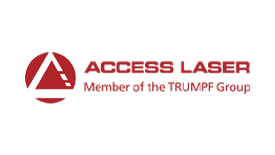Company
Founded in 1999, Access Laser Company develops and manufactures innovative solutions based on radio-frequency (RF) excited carbon dioxide (CO2) and other molecular gas lasers—from 100mW lasers to 50-watt lasers with peak powers as high as 1kW. The company offers a broad range of standard products, and often designs and builds custom lasers based on customer specifications.
Challenge
Access Laser has grown rapidly over the past four years. At any time, the company’s engineering team may have several dozen active projects, ranging from small efforts that take one to two months to larger projects that take more than a year. Many of the larger projects require a mix of research, experimentation, and engineering work, making them especially hard to estimate and track.
In the past, all projects were planned by a single engineering manager, using Microsoft Project. However, project plans weren’t shared or revisited over time, resulting in a major lack of visibility into who was doing what, how to bring those efforts together, and when projects would be done.
“Projects were planned in silos and were out of date as soon as the planning was completed,” says Courtney Rickett, Manufacturing Process Engineer and Quality Manager at Access Laser, who joined the company in early 2015. “We had very limited visibility into the status of any given project, which resulted in some really late delivery dates.”
Lack of effective project management presented other problems, too. A general lack of cohesiveness resulted in frequent mistakes and errors—from duplication of effort to things not getting done at all. Project designs diverged, time was wasted, and some products even had to be redesigned while they were in production.
“When one product release went horribly wrong, we knew it was time for a change,” recalls Rickett. “Senior management made the decision to hire a full-time project manager, and I was tasked with making sure that person had the right project management tools to do the job.”
Rickett immediately set out to find the optimal project management solution, evaluating a list of candidates that included Basecamp, LiquidPlanner, Targetprocess, and Workzone. “We needed a solution that was real-time, flexible, and easy to use,” says Rickett. “It also had to support many projects, accommodate changing priorities, and allow for many users.”
Solution
While each product Rickett evaluated had some desirable features, only LiquidPlanner provided all that she needed. “None of the other project management tools offered ranged task estimates, priority-based scheduling, and real-time schedule updates as people log their work,” she says. “LiquidPlanner had everything we needed, without all the fluff and clutter of some other project management tools.”
Next, Rickett had to convince her company’s executive team to purchase LiquidPlanner. She had already pushed for two new software solutions in the 18 months she had been with the company; LiquidPlanner would be the third, and the company’s CEO initially pushed back. “He finally agreed when I explained that the time LiquidPlanner would save our engineering manager alone was enough to pay for the solution several times over,” recalls Rickett.
Rapid Adoption
Access Laser purchased LiquidPlanner at the end of October 2016. Kody Todd, the company’s new Senior Project Manager, had years of experience with Microsoft Project. However, she immediately saw the value of LiquidPlanner and enthusiastically supported its adoption.
To help accelerate time-to-value, Access Laser took advantage of LiquidPlanner’s Quick Start Onboarding, which included dedicated support, training sessions, templates for training materials, and other tools. In the first training session, Access Laser learned how to architect its LiquidPlanner workspace, including methodology, plan structure, and suggested workflows. In the second, a LiquidPlanner consultant reviewed the company’s initial workspace, helped refine it, and provided other suggestions to increase efficiency. Access Laser chose LiquidPlanner Dashboards for its third training session, knowing that it would want to use start using that feature immediately.
“Quick Start Onboarding helped us get up to speed very quickly—probably a month faster than had we attempted to do everything on our own,” says Todd. “We created a LiquidPlanner playbook, which helped us think through things and get them right the first time. The training videos were also great—I watched every single one.”
LiquidPlanner had everything we needed, without all the fluff and clutter of some other project management tools.
Courtney RickettManufacturing Process Engineer, Access Laser Company
Onboarding helped us get up to speed very quickly—probably a month faster than had we attempted to do everything on our own.
Immediate Value
Access Laser began using LiquidPlanner in November 2016, as soon as projects were loaded. “The value provided by LiquidPlanner was instant, especially for upper management,” says Rickett. “It gave them an immediate picture of all we wanted to do, the resources to do so, and visibility into the status of all projects and where people were spending their time.”
About a month later, a major customer conducted an audit. “The customer had a very positive response to our use of LiquidPlanner,” says Rickett. “We’ve since created a LiquidPlanner dashboard for that customer and are using to track progress to their audit findings.”
The first project to be completed using LiquidPlanner—a custom laser-based on customer requirements—went smoothly. “It was one of those big ‘drop everything’ opportunities that required both research and engineering work,” recalls Rickett. “We estimated it at four months and came in fairly close to that, which was pretty impressive given our past track record. The customer was happy, and that first sale has led to additional opportunities.”
Of all the features provided by LiquidPlanner, Access Laser is finding several to be particularly valuable:
- Best case/worst case estimates, which help the company take uncertainty into account when estimating the tasks within a project.
- Predictive, priority-based scheduling, which dynamically recalculates the most likely completion date for all tasks and projects.
- Automatic resource leveling, which prevents the over-allocation of resources across one or more projects.
- Timesheets, which enable Access Laser to capture who worked on what as each task is completed—and apply that knowledge to improve task estimates for future projects.
- LiquidPlanner Dashboards, which provide at-a-glance visibility into project status—including early warning signs that a project may be headed off-track.
- Advanced reporting and analytics, which Access Laser is using to monitor project status and deliver real-time reports to executive staff.
Access Laser has since expanded its use of LiquidPlanner beyond its engineering department. More than half of the company now uses it, including all of engineering, the executive team, and key people from the company’s marketing, manufacturing, production, and finance teams. “We currently have more than 70 projects in LiquidPlanner,” says Rickett. “We’re using it for everything from process improvement and new production tooling to marketing campaigns, continuous improvement initiatives, and facilities relocation.”
Benefits
Through its use of LiquidPlanner, Access Laser now has full visibility into project status and resource utilization. Individual work priorities are now aligned with project priorities, resulting in faster project deliveries. Project estimates are more accurate, less time is spent determining project status, and separate timekeeping mechanisms are a thing of the past. The company’s use of LiquidPlanner is also helping Access Laser to capture, formalize, and evolve its business processes—all leading to a strong return-on-investment.
Full Visibility Into Project Status and Resource Utilization
Access Laser’s adoption of LiquidPlanner gave the company immediate, real-time visibility into the status of all projects—including who’s working on them, the amount of time being spent on them, and when they should be done. “With LiquidPlanner, we can easily see when there’s a risk to a project,” says Rickett. “And if we need to reprioritize, LiquidPlanner shows us the effects that such decisions will have on all other projects. It’s great for staying on top of things in a fast-paced company such as ours, where there’s lots going on and things can change rapidly.”
Consistent Priorities—and Faster Project Delivery
Previously, with so many projects going on, people often had to guess at priorities. Today, people can always see their top priorities on their personalized My Work pages, letting them know exactly what they should be working on—and enabling others to hold them accountable—as everyone works together to accomplish shared priorities. The end result: projects are being delivered faster, with fewer delays due to faulty assumptions about who’s supposed to be doing what and when it’s needed.
More Accurate Project Estimates
According to Rickett, the best case/worst case estimates in LiquidPlanner are proving useful in helping the company predict project delivery dates. “The range-based task estimates in LiquidPlanner are especially helpful when it comes to tasks that require research, invention, or experimentation, as many of the tasks in our project schedules do,” says Rickett. “And with the amount of work for each task captured in the system, we can look back on past task estimates, see how close they were, and use that information to better estimate similar tasks in the future.”
Significant Time Savings
Today, people at Access Laser don’t have to spend nearly as much time determining the status of projects—leaving more time to make progress on them. “In the past, the senior managers might have to spend hours meeting with different employees to understand status on various projects,” says Todd. “Now we can get that information very quickly, without needing to track people down. As the person responsible for managing the multitude of technology and product development projects here at Access Laser, I can’t imagine doing my job without LiquidPlanner.”
Integrated Timekeeping
In the past, Access Laser used a separate time tracking tool based on Microsoft Excel. Today, the company is using LiquidPlanner to log hours against project tasks and keep timecards, easing the capture of time card data while enabling the company to get more out of it.
More Mature Business Processes
The company’s use of a real project management tool is helping Access Laser to formalize and evolve its business processes, especially those that relate to product and technology development. “In the past, nobody really had the big picture when it came to all the tasks needed to release a product and how they all come together,” says Rickett. “Today, we have all that information in LiquidPlanner, in a way that lets us easily apply it to each new project. LiquidPlanner isn’t the only investment we’ve made in maturing our processes, but it’s the cornerstone that’s helping us bring all those investments together.”
Strong Return on Investment
Although she can’t quantify it, Rickett believes that LiquidPlanner is delivering a strong return-on-investment. “Being able to effectively schedule, monitor, manage change, and deliver projects on time makes our modest investment in LiquidPlanner well worth the cost,” she says.
Yong Fang Zhang, the company’s CEO, who was skeptical whether Access Laser really needed LiquidPlanner at first, is in full agreement with Rickett. “LiquidPlanner enables us to manage multiple projects with cross-functional teams, where everyone participates in more than one project,” says Zhang. “It allows us to quickly adapt to real-life changes in customer requirements and priorities, and to see the impact on the overall picture. We are an innovative company, and we need to quickly evaluate market changes and emerging opportunities. I’m convinced of the value of LiquidPlanner as a powerful tool to help us satisfy the needs of our customers.”


